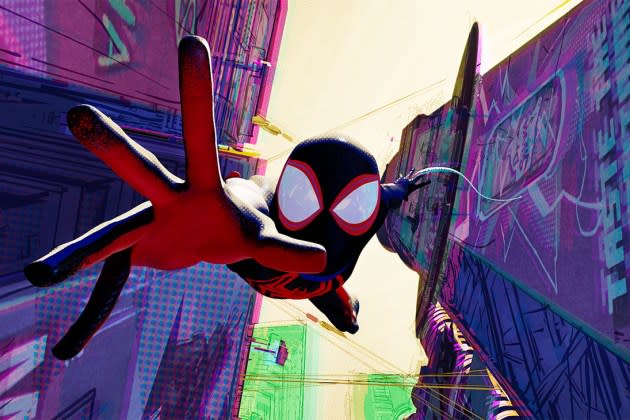‘Spider-Man: Across the Spider-Verse’ Review: A Thrilling Sequel Marks the Return of Miles Morales
- Oops!Something went wrong.Please try again later.
- Oops!Something went wrong.Please try again later.
- Oops!Something went wrong.Please try again later.

In Spider-Man: Across the Spider-Verse, Miles Morales is all grown up. Well, sort of.
The events of the second chapter of the Spider-Verse series, sleekly directed by Joaquim Dos Santos, Kemp Powers and Justin K. Thompson, take place a year after a radioactive spider bit our protagonist’s hand. Since then, the arachnoid warrior (voiced by Shameik Moore) has grown into his powers and superhero responsibilities. Miles shoots silk threads with more precision, swings across the city skyline more smoothly and can make himself disappear on command (instead of at random, inconvenient times). He’s also got a better handle on the saving the world shtick.
More from The Hollywood Reporter
'Spider-Man: Across the Spider-Verse' Swings to $17.4M in Box Office Previews
Surprise: Dwayne Johnson Returning for New 'Fast and Furious' Movie
But Miles, now 15, is also a teenager, which means protecting New Yorkers isn’t his only concern. When not chasing foes or signing brand deals, he’s attending classes at his tony magnet school, preparing to apply to college and trying to find enough time to spend with his parents, Jefferson (Brian Tyree Henry) and Rio (Luna Lauren Velez). Early in this much-anticipated follow-up, we see the two adults impatiently waiting in the guidance counselor’s office as their son slowly makes his way across town. At each intersection, Miles’ senses go off, pulling the teen into a new crime-fighting situation and making him increasingly late for this very important meeting. The set piece — with its kinetic animation and self-aware dialogue — represents some of the best parts of the Spider-Verse series.
Spider-Man: Into the Spider-Verse wowed and wooed audiences with its limber storytelling, inventive animations and refreshing humor. That film, which went on to win the Academy Award for Animation in 2018, was special because it shed the self-consciousness that plagued so many contemporary superhero adaptations. Miles Morales, a Puerto Rican and African American kid who loved to tag the city walls with his art, was a new kind of superhero. He was funny, very cool and well-versed in his franchise’s history. He anchored Into the Spider-Verse, which was buoyant and slick.
Across the Spider-Verse vibrates with the same energy as its predecessor even when it feels more leaden with backstory. This chapter is the first of a planned two-part sequel to Into the Spider-Verse. Dividing the follow-up in half gives the screenplay, written by Phil Lord, Christopher Miller and David Callaham, more room to settle into the ridges and grooves of Miles’ story. The additional space proves to be both a gift and a curse as Across the Spider-Verse pulls us deeper into Miles’ world.
The film begins with Gwen (Hailee Steinfeld) giving us the requisite backstory to her character. Just as in Into the Spider-Verse, these opening monologues satirize the self-important and repetitive nature of superhero introductions. “Let’s do things differently,” Gwen says to us in what could be considered this franchise’s tagline. She starts to tell a story we already know, rehashing the events of the first film with details that give us a sense of her perspective. In the year since we last saw Gwen and Miles, the young woman has struggled to adjust to her world. Not only is she reeling from the loss of her friend, but she misses Miles and still can’t connect with her father (Shea Whigham). In an effort to bury her emotions, Gwen joins a band — but that doesn’t really work out super well.
Like the first film, the sequel is a visual feast, with each dimension of the Spider-verse retaining its own style. The colors of Earth 65 — where Gwen lives — bleed into each other so that each scene resembles a delicate watercolor piece. The environment, loose sketches that blend pastel blues, pinks and yellows, reflects the emotional cadence of its characters, too. When Gwen and her father get into a fight, the walls of their apartment are drained of color; in moments of intense action they are restored in their full vividness.
In this way Across the Spider-Verse gets even more serious about recreating the experience of reading a comic book. The animations are not just striking, but incredibly absorbing in each new dimension. When Gwen gets recruited to a special elite squad of Spider-men and women, informally led by Miguel O’Hara (Oscar Isaac) and Jessica Drew (Issa Rae), she jumps more freely within the multiverse, allowing us to see the full breadth of the Spider-Verse world.
There’s a free-wheeling energy to the way Across the Spider-Verse layers the styles of each dimension; rarely do they feel like they are clashing. Music supervision by Insecure’s Kier Lehman and Daniel Pemberton’s composition helps bridge these seemingly discordant parts with a stable sound. Gwen eventually visits Miles, who’s struggling to balance family, school and saving the world. The pressure of meeting all these demands weigh on the young superhero, who, despite feeling more secure, still finds himself stumbling. It’s nice to see their relationship get more airtime as the two young heroes help each other navigate the inherent isolation of their gifts.
In Across the Spider-Verse, Miles’ identity takes center stage, but not totally in the ways you might expect. The film retains its signature tone — moving between humor and sentimentalism with a light touch — but there’s a greater effort now to connect Miles’ origin story to broader lessons about superhero canons. That doesn’t always land as gracefully, and parts of Across the Spider-Verse feel weighed down by this need to belabor a well-established point. Still those moments can be forgiven as the story unfurls, revealing that Miles, with his new challenges, remains a hero worth rooting for.
Best of The Hollywood Reporter
